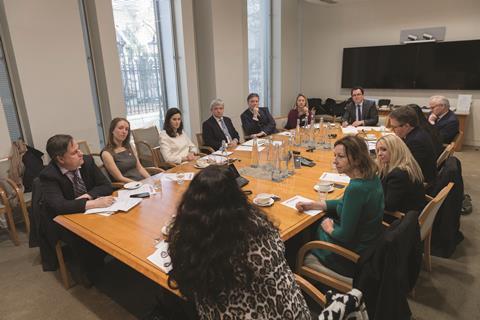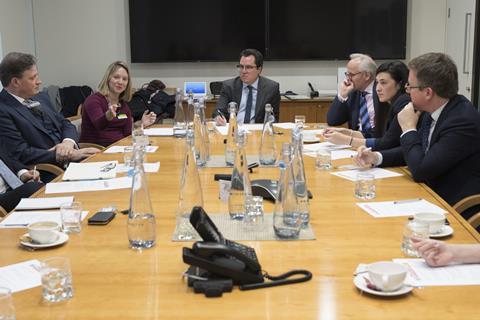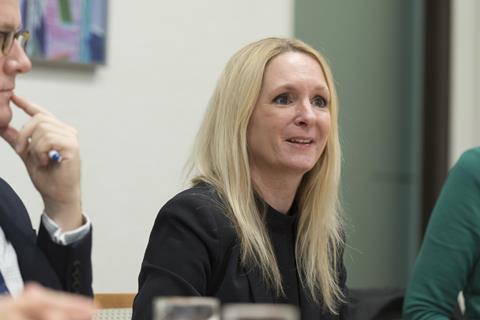‘I know [we’re] not popular among some members of the profession.’ So says Nick Johnson, director of the Legal Advice Centre at Nottingham Law School, at the outset of the latest Gazette roundtable. This is perhaps a surprising observation, since we are meeting in the wake of National Pro Bono Week – when events celebrating and promoting the profession’s commitment to free legal advice and representation for those who would otherwise not receive it jostled for space. In London, one attendee reflects, there were up to five events an evening: ‘Almost too much!’
The Gazette has never been pitched an opinion piece criticising pro bono. We publish the odd caviling letter. More common, however, are comments on the Gazette website following articles on pro bono. Commenters, usually registering as anonymous, imply that such efforts undermine the restoration of legal aid and take away work from lawyers who are trying to make a living in areas where pro bono work is offered. Or the competency of such efforts is questioned – take a recent sarcastic comment from the pseudonymous Marshall Hall (not, we assume, the greatly respected dead lawyer himself): ‘So you felt an “expert” in immigration law after one training session? I’m not sure that I would be an expert in cross-border M&A after one training session and then having an M&A lawyer on the end of the phone…’
Those present tackle such criticism head-on. The gap in provision is enormous; the restoration of legal aid is a long shot; and lawyers doing pro bono work commonly collaborate, rather than compete with, specialists in social welfare law.
Katie Fennell, who works for Kids in Need of Defense UK, speaks from personal experience. She is a lawyer with the specialist knowledge to represent clients and is salaried. But she can make limited resource go further: ‘You have to address that issue – I’m going to spend my time training and mentoring pro bono lawyers, and that takes me away from directly representing clients. So, it has to be effective… I have to be able to show that I can help pro bono lawyers represent more clients by supervising them than I could just do on my own.’
Fennell’s approach adds scale, done correctly; and scale, LawWorks’ James Sandbach reflects, is in urgent demand. He recalls the Civil and Social Justice Survey, once conducted by the now-defunct Legal Aid Board: ‘It came up with the same sort of findings pretty much every single year, which was a third of the adult population in England and Wales have unresolved legal problems in their lives. Only about one 10th of that group immediately get the advice they need. Half of them do get appropriate advice.
‘The Ministry of Justice did a conflict resolution survey a couple of years ago. What was interesting about that is it came up with almost identical findings.’
The backdrop to today’s need is well documented. The legal aid budget has fallen by £900m since LASPO took effect in 2013, taking swaths of civil law out of scope. Even the best hope for restoration of an element of the budget, proposals contained in the Bach review, envisages only a £400m increase. The position before 2013 also left many with need outside of scope after decades of salami-slicing.
‘It hasn’t just been legal aid,’ Johnson adds. ‘It’s also been local authorities which have withdrawn advice services.’
Withdrawal of the resources that advice centres depend on hits pro bono efforts too. As Johnson points out, to general agreement at the table: ‘Volunteers are not cost-neutral. They give their time for free, but they sometimes cost the organisation that they volunteer for.’
Against a background of such sparse provision, a priority is to make the partnership between pro bono advice and expertise, and the coordination that makes it possible, a highly effective one.
Identifying need
Does that mean starting by identifying the most urgent need? As Sandbach notes: ‘We can see that actually, the pro bono resource doesn’t necessarily spread very far… So we have to be very careful, and very skilful and strategic about how we use and deploy the pro bono resources that we have.’
Certain areas quickly emerge as priorities from such reflection, Johnson notes: ‘I would suggest family, employment, small business advice, immigration advice, welfare rights – that’s my top five.’
Bates Wells Braithwaite partner Paul Jennings notes that his firm’s clients, especially charities, help the firm with ‘spotting trends and getting referrals’. In particular, that has related to the ‘“gig economy” and difficulties people are facing with the erosion of employment rights’. The firm’s pro bono work in this area has delivered landmark judgments in clients’ favour, including cases brought against Uber and CitySprint.
Some needs have been vastly increased by poor paid-for advice that clients have received in the past. This is especially prevalent in immigration. Helena Milner-Smith of Covington & Burling recalls the context given in a background briefing she received before working on her first immigration case – urgent assistance for a child who needed leave to remain. ‘It also talked about the fact there are a lot of shark-lawyers in the immigration area charging clients a lot of money to give terrible advice, [and] very shabby applications. Advice on things like sham marriages, which then makes someone’s future chances of getting an immigration application cleared much more difficult.’
‘Immigration is a particular problem,’ Goodman Derrick partner Stephen Hornsby confirms. ‘I think that an advantage for the “sharks” is often language ability.’
When it comes representation work, Colm Nugent, a barrister at Hardwicke, observes a further complication he deals with in pro bono work: ‘The thing I find quite shocking is the rise of the paid McKenzie friend who is not insured, and who doesn’t have any supervising body or monitoring body. These people are taking huge sums of money.’
Fennell adds: ‘It’s a result, isn’t it, of not being able to access legal advice. It allows sharks to flourish.’
The priority for her, then, is ‘increasing capacity of specialist, good-quality, legal advice, whether that’s pro bono or paid-for – or legal aid’. She expects lawyers who (like Milner-Smith) have worked on Kids in Need of Defense UK to bring the resource and professionalism to their instructions that a firm like Covington would exercise with a fee-paying client. As a result, she says, ‘it’s better than you would get at a law centre, because we don’t have the resources… if I have to photocopy a lot of stuff, I have to do that myself. I don’t have a secretary to do it. The level of work is just fantastic, so from what I’ve seen, there is no issue with quality.’
Reed Smith’s global pro bono coordinator, Rebecca Naylor, says firms need to recognise that quality of advice is a central concern. ‘The challenge for commercial firms is that we often don’t have the expertise that’s required to do end-to-end work on some of these cases,’ she explains. ‘So it’s critical that wherever we’re doing the pro bono work, we’re working firstly with, probably, a local legal advice centre [which] can refer the cases and properly assess them, and then with specialist lawyers in that particular area to make sure we’re giving the best advice possible.’
Wilsons’ Caterina Franchi highlights the dangers inherent in trying to ‘multiply’ the benefit of pro bono advice. It is a set of dangers very relevant to the advice she and colleagues provide to refugees (projects that have taken her to work for clients in Athens).
‘I think it can be very risky, especially with the clients that I work with,’ she explains. ‘They’re very vulnerable. Sometimes [they] give advice to one of their friends, the advice is not really understood, or is not seen in the broader scheme of things, and then that multiplies in a negative way to a lot of other clients.’ She adds: ‘Refugee communities do that quite a lot. One person gets legal advice and then spreads the word – the wrong word. Then it takes 10 times as much … advice… to try to patch up what has been done.’
Whereas ‘it’s perfectly possible with clients that are less vulnerable and more capable of understanding the advice’, Franchi concludes, ‘that’s not the case with the clients that I see’.
Building a consistent standard and commitment to pro bono work is the goal of Law Society initiatives such as its pro bono charter and pro bono protocol. The Law Society’s Rebecca Wilkinson, pro bono and public legal education policy adviser, explains: ‘The pro bono protocol… is about 15 years old. It was developed with the Law Society, the Bar Council and CILEx, through the then attorney general’s pro bono committee. Upwards of 200 firms are signed up. It lays out how you should do your pro bono work. While it is a reasonably long document, it essentially says “handle your pro bono work in the same way as you would do any fee-paid work”. Anyone who signs up to the pro bono charter has to sign the protocol. Our only requirement is that you must see pro bono work as on a par with any other work that you would do.’
Supporting such work was the launch last year of the Pro Bono Manual – a 350-page document the Law Society developed in collaboration with 12 firms, LawWorks and LawSense.
A commitment to pro bono is increasingly inculcated in law students who have enhanced opportunities – and incentives – to undertake it. Royd Withy King’s Rebecca Stevens says their commitment can help complete ‘quite a lot of the groundwork’ in some cases. That is worthwhile, she says, for students who ‘in the future want to apply to you’.
‘Most of the people that apply to our firm for training contracts now are saying, “How do I make myself stand out? How do I do something that’s relevant that will give me an edge to get a training contract?”,’ Stevens adds. ‘You remember the quality work that they did for you.’
A strong personal commitment to a client or case-type is one important guarantor of quality, notes Morag Peberdy, of counsel at Covington & Burling: ‘We’re part of the various clearing houses like LawWorks and TrustLaw, so every week we get emails that get circulated so people can volunteer for things that interest them,’ she says. ‘A big part of it is people having interests outside these four walls, whether it’s from law school or from another firm, or they are involved with a charity. We get people saying, “It’s close to my heart, and they’ve got legal needs. Can we on-board them?”. Ninety-nine times out of 100 we can… The idea of getting most pro bono work done is, “What are people passionate about?” They’ll do more hours and they’ll do it better.’
That involves some recognition in the targets lawyers have, Naylor notes: ‘Lawyers have to hit some targets to get their bonus, but up to 120 hours of their pro bono work counts. The firm thereby really shows its lawyers that such work is valued, which helps us to encourage all of our lawyers to participate. Though I think they’d do it anyway, to be honest.’
Naylor observes: ‘It is our busy lawyers that do pro bono… at the end of the year, if we look at who’s done the pro bono work, it is the lawyers who are really, really busy who have hit those targets anyway.’
Effectiveness
How should lawyers reflect on whether their pro bono work made a difference? Can (or should) the impact be measured in more than hours? ‘Monitoring and evaluating takes resources,’ Wilkinson points out.
It is a difficult area, not least because counting ‘wins’ would not capture the real value of much advice. Hornsby explains: ‘There’s a value in just being with someone. Some of the immigration cases are just hopeless. They’ve lied two or three times, they’re going to get thrown out. But if you’re there, representing them and putting the best case forward, saying they regret that they lied… you know what the outcome is going to be, [but] you’re providing a [service of] great value even when they [fail].’
LawWorks has done some work on monitoring and evaluation. ‘We did a pilot,’ Sandbach explains, ‘finding clients a year after they received advice and seeing what the outcome [was].’ He describes this as ‘the effective standard impact management tool for clinics’, not least when those clinics are looking to secure funding. Being able to answer the question: ‘What outcomes are we able to demonstrate?’ is important. ‘I do think that with any effective case management system, you can build in quite simple “outcome” follow-up tools.’
Johnson notes that the client is also a key decider of the outcome. That is especially the case where clients take advice or support and then have a role in using or applying it. ‘A lot of the research suggests it’s based on your own educational attainments,’ he says. ‘The recipient of the service, if they’re educated to say, A-level standard, will be able to take that and use it much more effectively than somebody who hasn’t had great success in formal education.’
Other measures, while not reflecting the full ‘value’ of what’s provided, are still worth collecting, Johnson says: ‘Sometimes, you can evaluate a service relatively easily. We would look at our tribunal cases and say, “We’ve recovered this amount in benefits for people over this period of time”, or “We’ve had this number of compensation [wins] in employment tribunals”. Those things are quite easy to measure, but I think something which looks at the impact of advice, three, six, 12 months down the line, is really important. I think it’s also really important to say to policymakers that advice is quite crucial.’
The context in which such things are assessed will change, though, he observes: ‘The system of law and the core processes are changing so rapidly through technology and digitisation and pro bono will be influenced and impacted quite a lot by [this].’
Of one mind
The engagement that those around the table have had with unmet legal need, and the scale of that need, leads to the conclusion that the scope of funding such as legal aid needs to be vastly expanded. There is no dissent from that view.
Some present are involved in the policy and advocacy work that aims to change public policy in this area. ‘We also do policy, public affairs and advocacy work around access to justice,’ Sandbach points out.
Naylor adds: ‘We work closely with international offices to do some projects that are wide-ranging.’
The position here is best summarised by Stevens’ conclusion: ‘There is a real split in the profession between those who criticise people who do pro bono work, thinking that we are not trying to make a stand against the government, or to say, “the cuts in legal aid are wrong”. They think that we are the sticking plaster over the gushing wound. [We] are actually saying, “Well, we do feel that it’s wrong, but someone’s got to do something… We’re doing it.’
Charter
The Pro Bono Charter is a pledge that firms, ABSs and in-house teams are invited to sign up to. At its heart is a ‘Statement of Commitment’
Protocol
The Pro Bono Protocol was developed under the auspices of the attorney general’s Pro Bono Coordinating Committee and seeks to build upon the Professional Codes of Conduct that set out the standards and requirements that all lawyers must achieve and observe
Manual
The Pro Bono Manual is a practical guide to developing a law firm pro bono programme
This roundtable was kindly hosted by Covington & Burling, London











































No comments yet